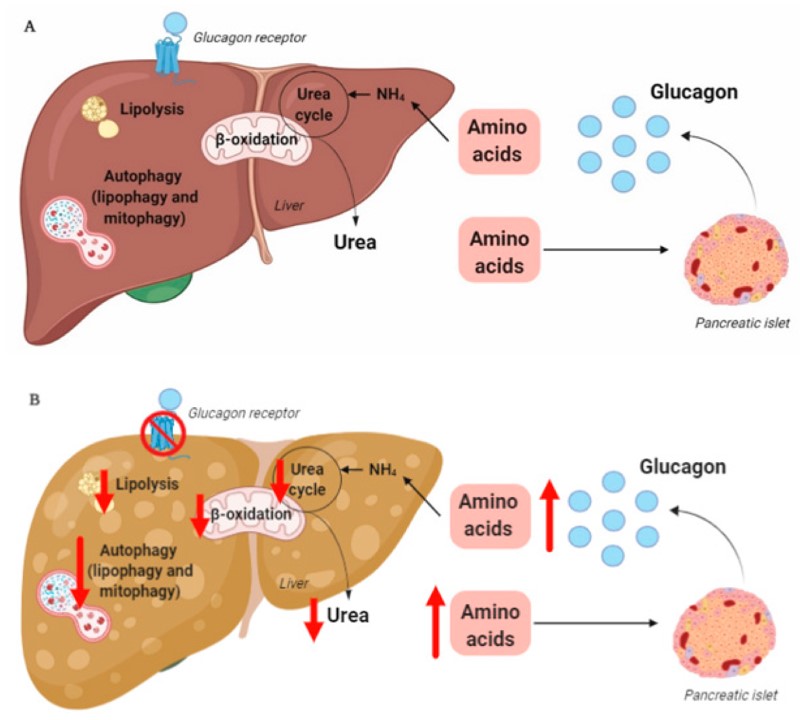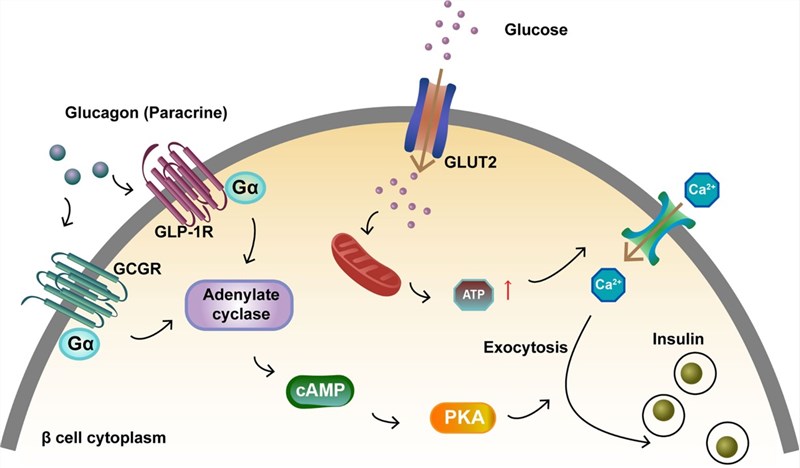Hi-Affi™ In Vitro Cell based Glucagon Receptor Functional Assay Service
Glucagon Receptors with Outlook
The glucagon receptor (GCGR) is a Class B GPCR that regulates the secretion of glucose from the liver into the bloodstream in response to glucagon. It plays a significant role in the maintenance of glucose homeostasis and is hence regarded as a viable target for the treatment of diabetes, obesity, and hypoglycemia. These disorders are significant contributors to the hazards facing human health. Whereupon, fully comprehending the glucagon receptors carries weight on the drug development of diseases.
 Fig.1 Glucagon receptors mediated hepatic glucagon resistance.1
Fig.1 Glucagon receptors mediated hepatic glucagon resistance.1
Creative Biolabs Incorporates An In Vitro Cell-Based Assay with Functional Assays for Glucagon Receptor
Cell-based in vitro assays with high sensitivity and reproducibility features have been a powerful tool for the discovery of structurally diverse compounds that may have therapeutic potential. In order to boost the development of drug discovery, Creative Biolabs incorporates this approach with GPCR functional assay and has successfully developed a Hi-Affi™ in vitro cell-based glucagon receptor functional assay service.
In our Hi-Affi™ in vitro cell-based glucagon receptor functional assay service, we characterize compounds and their capacity to modify glucagon receptors by examining changes in second messenger concentrations and downstream calcium fluxes caused by receptor activation. Creative Biolabs is dedicated to providing top-ranking services and presenting high-quality outcomes for global customers. Meanwhile, we are capable of helping each customer to:
- Design experiments
- Select the appropriate approach to analyze
- Develop and verify the specific assay(s)
 Fig.2 The activation of glucagon receptors.2
Fig.2 The activation of glucagon receptors.2
Benefit for You
Our Hi-Affi™ in vitro cell-based glucagon receptor functional assay service has the capacity to benefit you with:
- A wide variety of cell types
- Robust and reliable experiment systems
- The highly sensitive and repeatability of experiment systems
- Professional and experienced research teams
- A full range of customized services
Case Study
| Development and characterization of a novel glucagon-like peptide-1 receptor antibody | |
| METHODS: The researchers employed a naïve phage display selection technique to extract single-chain variable fragments (ScFvs) that bind to GLP1R. Glp1R0017, the ScFv with the greatest affinity, was transformed into a human IgG1 and further characterized. | RESULTS: Glp1R0017, a monoclonal antibody to GLP1R, was chosen from naïve antibody phage display libraries. GLP-1R antagonistic activity was limited to cells overexpressing GLP-2 receptors, the glucagon receptor, or the GIPR. Glp1R0017 inhibited GLP-1-stimulated cAMP and insulin production in INS-1 832/3 cells. |
 Fig.3 GLP-1 reversed the antagonism of Glp1R0017 to mouse GLP-1R.3
Fig.3 GLP-1 reversed the antagonism of Glp1R0017 to mouse GLP-1R.3
Partner with Us

Creative Biolabs, as a frontrunner in the GPCR functional assay field, is committed to offering cutting-edge service and innovative approaches to every customer. If you have any questions concerning our Hi-Affi™ in vitro cell-based glucagon receptor functional assay service, feel free to contact us. Everyone here can't wait to get started working with you.
References
-
Galsgaard, Katrine D. "The vicious circle of hepatic glucagon resistance in non-alcoholic fatty liver disease." Journal of Clinical Medicine 9.12 (2020): 4049.
Distributed under Open Access License CC BY 4.0, without modification. -
Jia, Yunbo, et al. "Role of glucagon and its receptor in the pathogenesis of diabetes." Frontiers in Endocrinology 13 (2022): 928016.
Distributed under Open Access License CC BY 4.0, without modification. -
Biggs, Emma K., et al. "Development and characterization of a novel glucagon-like peptide-1 receptor antibody." Diabetologia 61 (2018): 711-721.
Distributed under Open Access License CC BY 4.0, without modification.
For Research Use Only.
